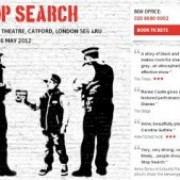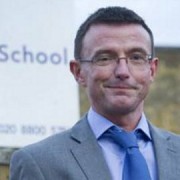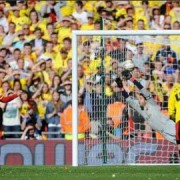As part of EastLondonLines series on the London Mayoral Election, Douglas Pyper looks at the history of low turnout in mayoral elections and asks, who is really electing London’s mayor?
Sadiq Khan and Zac Goldsmith have become ubiquitous faces on our TV sets and newspapers over the last few months. Coverage of their campaigns will only increase between now and the mayoral election on May 5, but outside of the chattering classes, does anybody really care?
The turnout for every London mayoral election to date has been shockingly low. Just 38 per cent of Londoners had their say in 2012 when Boris Johnson was elected. That means less than two out of five people exercised their right to say who runs their city.
Turnout isn’t consistent within boroughs. In some electoral wards such as Downham, Lewisham, turnout drops even further. Here just one in four people voted in the 2012 election. When ELL asked passers by on Downham’s Bromley Road on a cold February afternoon, only a few said they planned to vote on who should next hold the reigns of power in London.
But some of those unwilling to vote, had strong opinions on why they would not.
“Each mayor is like the one before,” said Martin Reynolds, “It is all one-sided political agenda for the upper middle classes. Their voice doesn’t represent the working class British person.”
Michelle Dixon said: “They are only interested in anything that can make money and I can’t make them any money so they are not interested in me.”
Pollsters Ipsos Mori estimate those on low incomes, the young, BME individuals and people living in social housing are statistically the least likely to vote.
Downham adheres to this pattern with high levels of social renting and low wages. The London wards with the highest and lowest turnout in mayoral elections (East Sheen in Richmond, and Parsloes in Barking and Dagenham respectively) also conform to this pattern.
In ELL’s home boroughs of Croydon, Hackney, Lewisham and Tower Hamlets the same pattern emerges with the exception of Weavers in Tower Hamlets, where relatively high levels of social renting, 18-24 year-olds, BME individuals and low income households has also resulted in a higher than average turnout percentage.
This could perhaps be due to Tower Hamlets being a particularly ethnically diverse borough with a lower than average age demographic. The borough may also be more politically motivated than others due to tension between immigrant communities and supporters of far-right groups such as the British National Party who won their first council seat there in 1993.
It is notable that two of the passers-by in our video – Martin and Michelle –complain of disaffection, saying that politics is not for people like them. This leads them to disengage from the political system, which in turn lowers the turnout. The fact is: those who do not vote are invisible to politicians, and policies will not be enacted to win their vote.
The irony is that in London, voters may have more power than they think: Boris Johnson was re-elected mayor in 2012 by a margin of just 82,013 votes, while 3,600,817 eligible voters stayed at home.
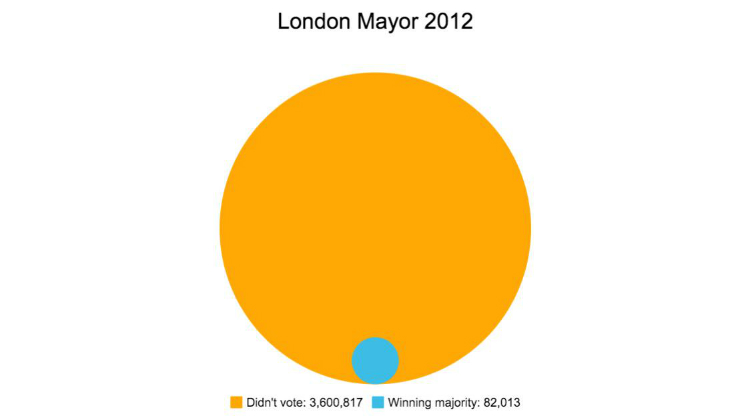
Addressing this issue is Bite the Ballot, a non-profit organisation set up to increase the amount of people registered to vote.
During their National Voter Registration Drive in 2015, the group signed up 441,500 people to the electoral register, potentially bringing them in to the political process.
Their main focus is young people, one of the key groups unlikely to vote and underrepresented by political policies. Bite the Ballot believe that under half of 15-25 year olds are registered to vote and that less than half again turn out on polling day.
Bite the Ballot’s Community Engagement Officer, Ashar Smith rejects the notion that apathy is to blame. He cites a lack of political education in UK schools and – like those on Bromley Road – a lack of representation in political debate.
“We ask people what they think of when they hear ‘politics’,” said Ashar, “Very often it is old, and it’s white, and it’s male. And the people in our sessions aren’t those things. Being represented is a big [reason for not voting].”
In Bite the Ballot sessions at schools, youth clubs, colleges and faith groups across London, encouraging young people to register is only half the battle; they must also be motivated to want to take part in politics.
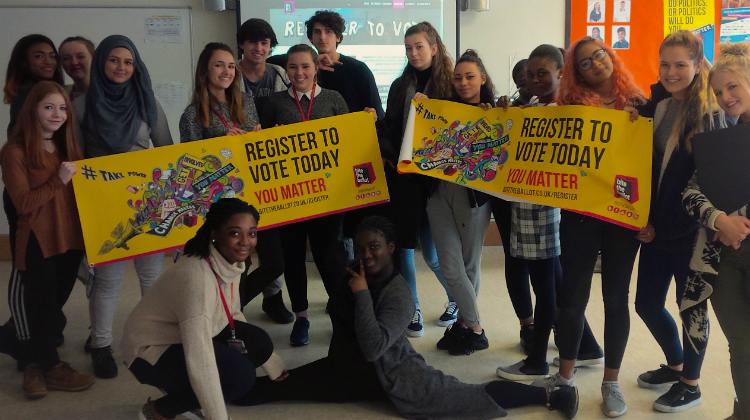
Students at Chace Community School in Enfield support the National Voter Registration Drive. Pic: Bite the Ballot
Ashar argues that the consequence of not voting is that young people’s political needs are not met, as evidenced in the decisions to raise tuition fees and close youth services.
His colleague Josh Pugh agrees: “If you’re not screaming as loud as you can to get heard then it’s going to be really easy for people to not hear you.”
For both Josh and Ashar there is a fundamental imbalance in political education. With so much education happening outside the classroom, an individual’s political awareness can rest on who their parents are, whether they went to university, and whether they live in a house where political debates take place.
“We’re trying to reach marginalized communities and make sure that anyone who wants to have a say gets a say,” said Josh.
While the work of Bite the Ballot will be pivotal in engaging more people with politics and bridging the gap between constituents and the people who represent them, Ashar feels more need to be done by the politicians at the top.
“We want democracy to be more representative and inclusive and accessible,” said Ashar, “I think that is a statement of intent for all of the mayoral candidates.”
Tomorrow: in day three of our series on the London Mayoral Election 2016, we will be looking at the housing crisis in the ELL boroughs, and how the main candidates intend to fix it.
Read the other articles in this series here:

